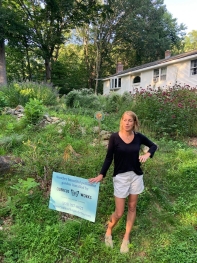
It was 2019 when Heather Bradley accidentally killed a frog with her lawnmower.
"It hit me that keeping a turf lawn was a total waste of time, space, and resources, not to mention a detriment to ecology and the environment," said Bradley.
The plight of the little frog energized her. Other turning points have energized others to pay attention to pollinators, so Bradley is not alone. Pollinator and wildlife protection is taking off at the town, regional, and national levels. Stories that follow represent their rapid growth.
National programs
If you read this blog regularly, you may recall the July 2021 article about the National Wildlife Federation's "Garden for Wildlife“ program, an ambitious, coordinated effort to put hundreds of thousands of seed-grown, neonicotinoid-free native plants into the nation's landscape. The NWF created native plant "kits" that could be shipped directly to customers with instructions. The kits contained science-based collections of pollinator "keystone" plants for the northeastern US and Midwest ecoregions.
"We've sold over 16,000 plant kits as of August 2022," says Mary Phillips, Gardens for Wildlife director. "We went from four plant collections in 2021 to 22 product offerings this year. We started serving ecoregions in 20 states (including Connecticut), but now we're up to 36 states," she said.
Regional programs
"Pollinator protection doesn't take an act of congress. You can just do it," says Louise Washer of Norwalk. She believes that's one reason the popular Pollinator Pathway movement has taken hold so quickly. "People feel the urgency to protect wildlife right now. This concept is simple, free, and all-volunteer."
Washer was part of the original steering committee that launched the Pollinator Pathway concept in Wilton, CT, in 2017.
"We realized that habitat fragmentation is a death sentence for species that can't travel more than a few hundred feet," said Washer. As they discussed ways to address the situation, she said, "A lightbulb came on."
Committee members established the first Connecticut pathway in the Wilton area. Today, about half of Connecticut towns have Pollinator Pathway participants, including every shoreline town from East Haven to Stonington. Many towns have local coordinators and post the project on their town websites.
The movement caught on in Massachusetts, Maryland, New Jersey, New York, Ontario, Oregon, Pennsylvania, Rhode Island, and Vermont.
"Our newest addition is a pathway of 20 towns in the state of Washington," said Washer.
Personal Inspiration, Local Action
Now, let's go back to that fall day in 2019 when a frog met a bad outcome beneath Heather Bradley's lawnmower. The incident convinced her to reduce turf. Equipped with the reading she completed that long COVID winter, Bradley covered her front lawn in cardboard and compost and planted about 1,000 plugs of native plants beginning in March 2020.
"Once the planting started to take off, I thought, wouldn't it be great to get people to see what's possible with a turf-lawn conversion?" said Bradley. She decided to organize a pollinator tour in Guilford and went in search of like-minded property owners who would open their yards to visitors.
"Now, I plan to host this tour each year. With Pollinator Pathway's assistance, it should grow exponentially."
Who'd have thought a tiny frog could make such a difference?
Read the complete story at Zip06/TheDay.
